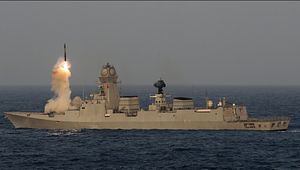The Indian Navy’s senior officer, Admiral Sunil Lanba, the chief of naval staff, said on May 30 during the Passing out Parade of the 132nd course of the National Defense Academy at Khadakwasla near Pune in the Indian state of Maharashtra that the service is ready for any contingency when it comes to the increased presence of Chinese warships in the Indian Ocean and militancy from Pakistan.
“We are ready for any contingency and whatever decision [the] government takes, we will fulfill our task,” the admiral told reporters in response to questions about the People’s Liberation Army Navy activities in the Indian Ocean and the Navy’s preparedness for another Mumbai 2008-like terrorist attack, according to The Economic Times.
The senior officer emphasized that the Indian Navy’s presence across the globe has been steadily increasing over the last couple of years.
“Over the years our footprint has been increasing. We have increased our deployment. We have a ship that is permanently stationed in the Gulf of Eden and the ship of the western fleet has just done a foray into Mediterranean and gone all the way into Atlantic,” Lanba told reporters.
The admiral noted that the Indian Navy has recently concluded an exercise with the Republic of Singapore Navy, the Singapore-Indian Maritime Bilateral Exercise (SIMBEX), which first began in 1994. The exercise involved four warships of the Indian Navy’s Eastern Fleet and a Boeing P-8I Neptune advanced maritime patrol/anti-submarine warfare aircraft.
The taskforce included INS Kamorta, the first of four anti-submarine Kamorta-class stealth corvettes; the INS Shivalik, the lead ship of India’s first class of stealth multi-role frigates; the INS Sahyadri, another Shivalik-class stealth multi-role frigate; and the INS Jyoti, a Komandarm Fedko-class replenishment oiler.
The ships are now “en route to Australia, where they are going to exercise with the Australian Navy. So you see [the] Indian Navy is deployed from the Pacific to the Atlantic and this what we are going to do,” according to the admiral. The Indian Navy and Royal Australian Navy held their first-ever joint maritime exercise in October 2015.
India recently refused Australia’s request to dispatch warships to participate in this year’s trilateral Malabar naval drill, which involves the navies of India, Japan, and the United States. Reports indicate India denied Australia’s bid to participate for fear of antagonizing China.
The admiral also expressed satisfaction with the Indian Navy’s construction program.
“Way back in the early ’60s, we took a call that we are going to be a ‘builders Navy than buyers Navy.’ We built over 200 ships since the early ’60s in the Indian shipyards and at the moment we have 41 ships and submarines, all are under construction in defense and private shipyards and new assets are being inducted into the Navy,” he said. “We will have a capable and effective Navy which can operate in all the dimensions,” Lanba added.
However, it remains to be seen when exactly the 41 ships and submarines currently under construction will join the service.
The majority of acquisition programs in the Indian Navy have been suffering from multi-year delays, including the Scorpene-class (Kalvari-class) diesel-electric attack submarine, the Kolkata-class (Project 15A) guided-missile destroyer, the Visakhapatnam-class (Project 15B) guided missile destroyer, and the Vikrant-class aircraft carrier, in addition to India’s first domestically developed and built ballistic missile nuclear submarine, the INS Arihant.

































